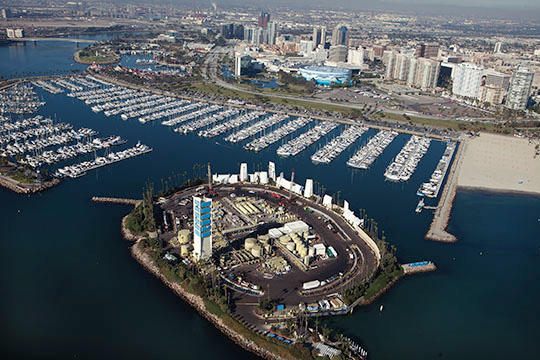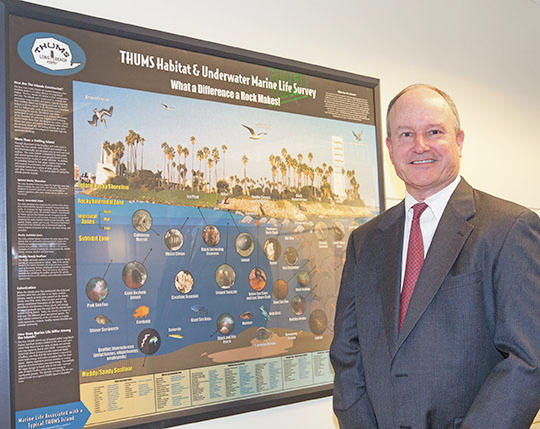It is an absolute certainty that the assignment placed before Joseph Linesch was one-of-a-kind. The architect’s background was largely in amusement parks – he had worked on designing the landscape at Disneyland in Anaheim and at Freedomland U.S.A. in the Bronx.
Now, in front of him, was an entirely different challenge – make a set of oil drilling islands aesthetically palatable to Long Beach residents with shorefront homes only a few hundred yards away from the proposed heavy industrial operations.

(Business Journal photograph)
What the firm of Linesch & Reynolds, along with sculptor Herbert J. Goldman and landscaper Morgan Evans, drafted is nothing less than an icon in modern industrial design. And it is not just the appearance that is unique. The THUMS Oil Islands are celebrating 50 years of operations – a half-century of successful co-existence with residents of Long Beach, the State of California and an environmentally sensitive ecosystem in the Long Beach Harbor.
“It was an exceptional design. The people who were involved at the time were very creative visionaries,” says Frank Komin, executive vice president, southern operations for California Resources Corporation, the company that currently owns the islands.
“Even today, those islands are viewed as one of the most innovative oil field designs in the world,” he continues. “The islands have grown to become icons in which the City of Long Beach takes a great deal of pride.”
In 1964, the courts ruled that the State of California had mineral rights to the oil located offshore of Long Beach. That included part of the Wilmington Oil Field, one of the largest deposits of oil and natural gas in North America. Long Beach voters gave the go-ahead to an ambitious plan to tap into that resource, but only within very strict guidelines, Komin says.
“The residents of the city voted to approve leasing – but under a very unique arrangement. It was to be done from four man-made islands that were designed to appear as tropical settings and to hide the development from view. That was the reason for the islands. There’s never been another model quite like it anywhere in the world,” Komin says. “The islands were required to blend in with the local landscape and scenery. The guiding principle was that the islands were to enhance, rather than detract from, the harbor’s natural beauty.”

California Resources Corporation’s Long Beach operations are led by Frank Komin, executive vice president, southern operations. He is in front of a poster that documents the types of animal life the THUMS oil islands support. According to CRC, “THUMS’ unique combination of production functionality, visual appeal and environmental and safety features has garnered the facility dozens of awards and recognition from local, state and national organizations. The Wildlife Habitat Council (WHC), a nonprofit organization that helps landowners enhance wildlife habitat, has certified all four THUMS’ islands for commendable wildlife habitat management and environmental education programs. Since 2004, the wildlife team at CRC has worked with WHC to establish California plant habitats on the islands.” (Business Journal photograph)
Before they could be sculpted, they had to be constructed. From Catalina Island, 640,000 tons of boulders – some as large as five tons each – were mined, then carefully placed to build up the perimeters of the islands. From the floor of the harbor – about 30 to 40 feet deep – the rocks were arranged to serve as the walls for the islands, each of which covers between 10 and 12 acres.
The next step was to dredge. Approximately 3.2 million cubic yards of sand were scraped from the harbor floor and poured into the center. At that point, the landscaping and equipment installation began. From the beginning, the impact on the nearby community was paramount – the closest island was only a few hundred feet from some very valuable real estate.
“Palm trees were planted on the exterior” Komin says. “Concrete facades were constructed for aesthetic purposes but also for practical purposes – to divert any industrial noise away from the residents living nearby. For noise abatement purposes, nearly all of the power that’s used to run the islands is electricity.”
The overall aesthetic direction deviated from the norm of the day, according to the website www.artdaily.com.
“The results reveal his [Linesch’s] interest in the aesthetic mitigation of technology – a departure from the contemporary modernist principles of the time, which celebrated industrial structures,” the website states.
And the plan was to do more than simply mask the operations from sight, but to integrate them into the seascape of Long Beach, according to the University Art Museum at California State University, Long Beach.
“What resulted was a camouflage that employed waterfalls, palm trees and shrubs set against abstract, brightly colored concrete walls and 180-foot tall towers – all dramatically lit at night. Linesch & Reynolds . . . worked to create a fantasy environment that would mask the working mechanical equipment of the oil platforms, and relate the islands visually to adjacent urban Long Beach,” curators wrote.
Given Long Beach’s prominent role in the region’s rich aerospace industry, it is fitting that the constructions are known as the Astronaut Islands. Each – Island Grissom, Island White, Island Chaffee and Island Freeman – is named after one of the first four U.S. astronauts killed in the line of duty. The name “THUMS” is derived from the original group of operators: Texaco, Humble, Union, Mobil and Shell.
Today, the islands produce about 35,000 barrels of oil each day. Oil, natural gas and water are pumped from the underground reservoirs, which are located between one-half and one mile under the floor of the harbor. The water is separated from the oil and reinjected into the ground to prevent subsidence. The oil and natural gas are transported to shore via pipeline and sold.
The decision by Long Beach voters 50 years ago to tap into that undersea resource has paid dividends for all parties involved. So far, the islands have provided more than $4 billion to the State of California and the City of Long Beach. And there have been other financial beneficiaries as well, Komin says. Thousands of individual property owners near the shore also owned rights to the oil field – and that has proven profitable to them and their heirs.
“The profits generated are returned back to those stakeholders, including over 6,000 individual town lot owners. Those were residents who owned a town lot near Ocean Boulevard. Even today, we’re cutting over 6,000 individual checks monthly,” Komin says. “Many of those town lot owners have passed them down to their heirs that might live in other parts of the world. The checks go to a lot of different places!”
And through it all, the islands have had a positive impact on the ecosystem of the harbor, and have been the recipient of several awards through the years.
“The one that received the most recognition would be the one that we received from the Aquarium of the Pacific for outstanding corporate environmental achievement,” Komin says. “We wanted to determine the impact the oil operation has had on the ecosystem. So we commissioned a team of marine biologists to study the islands. As you might expect, any time you introduce an artificial reef and keep the environment around it clean, marine life is going to flourish. And that’s what the study showed. We documented the results with a poster that shows the types of animal life that the islands now support.”
Komin says that, with a solid history of success in the books, that the islands’ future remains positive, and that they are likely to remain iconic representations of Long Beach for years to come.
“It is a maturing oil field that we believe has plenty of life, plenty of opportunity remaining. The field provides a strong revenue base for the city and state – and it provides quality jobs for our local economy,” Komin says. “Our intent is to continue operating in the safest and most environmentally responsible means possible and continue to build on the gains we’ve made in those areas. We think the application of new technology will go a long way to being able to fully develop all the oil and gas resources that are there. We intend to be a good neighbor and a fixture here in Long Beach for many years to come.”
